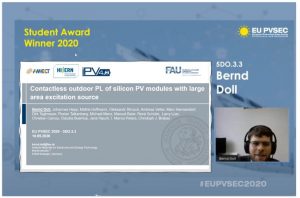 Every sector and industry relies on research and innovation to develop and succeed. This also applies to the PV sector, especially in times of energy transition, CO2 reduction and with plans for abandoning fossil fuels. For this reason, IBC SOLAR together with various other organisations, regularly supports students with their innovative ideas as a team partner in research and/or financially. This time, the team supported Bernd Doll, FAU PhD student from FAU in Erlangen-Nürnberg and presenter of the current iPV4.0 projects. With his contribution “contactless outdoor photoluminescence of silicon photovoltaic modules with large area excitation source”, the talented student has won one of the Student Awards at the “EU PVSEC 2020” – something that he can be very proud of – which of course we are!
Every sector and industry relies on research and innovation to develop and succeed. This also applies to the PV sector, especially in times of energy transition, CO2 reduction and with plans for abandoning fossil fuels. For this reason, IBC SOLAR together with various other organisations, regularly supports students with their innovative ideas as a team partner in research and/or financially. This time, the team supported Bernd Doll, FAU PhD student from FAU in Erlangen-Nürnberg and presenter of the current iPV4.0 projects. With his contribution “contactless outdoor photoluminescence of silicon photovoltaic modules with large area excitation source”, the talented student has won one of the Student Awards at the “EU PVSEC 2020” – something that he can be very proud of – which of course we are!
During the 5-day online event with 1500 participants from more than 60 countries around the globe, a total of 850 live presentations were held. In this context, thanks to Bernd Doll findings in the Outdoor Photoluminescence Setup, it is possible to measure large area photovoltaic modules without contact. This is of particular benefit for reliable energy production of solar parks. The results show that the output can be improved compared to electroluminescence by avoiding electrical contact without loss of information.
This research is another step forward in the PV industry and the result of team work, shared knowledge, diligence and hard work. All of this effort has paid and has lead to a useful technology that enables sufficient energy supply fully based on renewable energy. Our team at IBC SOLAR will definitely continue to develop concepts and products in cooperation with scientists and well-known leaders of the industry with the aim to increase the efficiency and professionalism of the PV industry.
The findings in detail:
Cost-effective tools for on-site defect detection help to ensure the reliable power production of photovoltaic (PV) plants. On-site examination is essential to minimize PV module damage, electrical yield loss and operation disruption caused by additional transport to the laboratory (off-site examination) or disruption of the electrical circuits. Outdoor inspection may be carried out by using highly sensitive imaging techniques, such as luminescence or thermal imaging. To avoid electrical contact switching time for electroluminescence (EL), we replaced intrusive electrical excitation by non-contact excitation with light, and measured photoluminescence (PL) instead. Nowadays, luminescence is used to detect defects such as increased series resistance, local cell irregularities, shunts and electrical disconnections in solar cells and modules. Our excitation source consists of twelve broadband, white, high power (100 W electrical power), chip on board light emitting diodes (LEDs) coupled with low-cost short pass filters. The light source is suitable for InGaAs and silicon (Si) detectors and mobile outdoor applications, which makes this setup a tool for on-site PL inspections for large area modules. The PL setup presented in this paper is capable of measuring large area PV modules of up to 72 cells with one image.
Authors:
B. Doll, J. Hepp, M. Hoffmann, O. Stroyuk, A. Vetter, M. Hemsendorf, D. Tegtmeyer, F. Talkenberg, M. Menz, M. Baier, R. Schüler, L. Lüer, C. Camus, C. Buerhop-Lutz, J. Hauch, I.M. Peters, C.J. Brabec